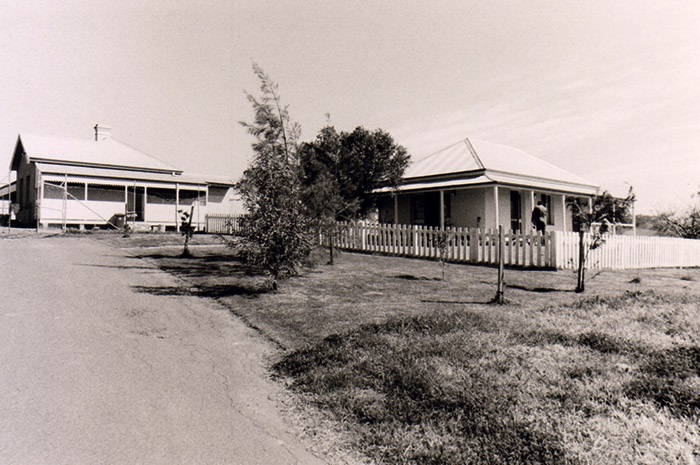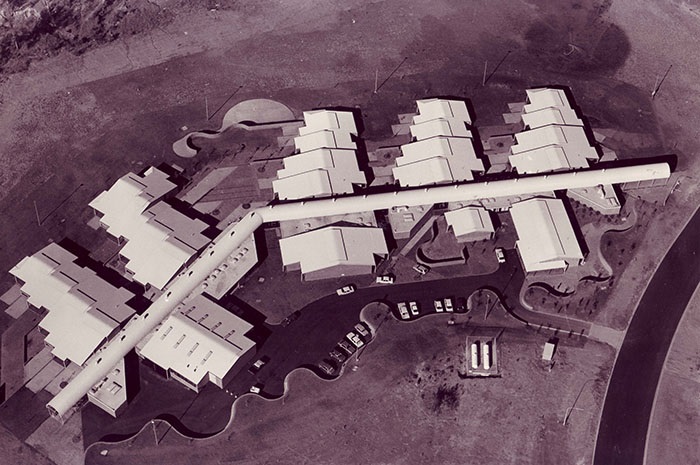History of Claymore
The following text is from "Campbelltown's Streets and Suburbs - How and why they got their names" written by Jeff McGill, Verlie Fowler and Keith Richardson, 1995, published by Campbelltown and Airds Historical Society. Reproduced with kind permission of the authors.
Claymore was not the original name chosen for this suburb. It was actually "Badgally".
Designed to honour the grand old hilltop homestead of the Moore family (now part of St Gregory's College), Badgally seemed a popular choice - at first. Yet in 1975, the whole idea was suddenly dumped by Campbelltown Council.
But why? Primarily because of the large amount of Housing Commission homes planned for the site. Some aldermen feared "Badgally" would be converted into rude insults such as "Bad Girlie" or Bad Gully". So as to compromise, the Claymore title was approved instead.
But where did Claymore come from? In retrospect, it seems the name is a largely inappropriate one.
Council only approved it under heavy pressure from the Housing Commission, which had begun prematurely using the name plan and promote its latest development. The Commission's justification for the title was that the property standing in the area had been called Claymore.
Yet a far more historic and worthy name - Glenroy - was ignored in the process.
Glenroy homestead(PDF, 176KB) may have been built as early as 1857 on part of a 55 acre (22ha) land grant awarded to Daniel Brady in 1816.
From 1929, it was operated as a dairy farm of 120 acres (48ha) by Great War veteran, Charles McClelland and his wife, Minnie. Glenroy remained in family hands until the 1960's, when much of it was purchased by the Commission.

Glenroy, Badgally Road, Campbelltown in 1985
The McClelland's son, Allan, still sees red over the way the name Claymore was selected.
"Because Glenroy has been synonymous with the region for years, I felt it should have been used for the suburbs name," he told the local press in 1995.
The so-called Claymore farm was actually Rosslyn when the Bursill family owned it from 1921-1936. And in the 1940's, when it was sold to Dr Abbott, it was renamed Bukit Senung. It wasn't until the 1960's that an owner called Vanderbilt called the property Claymore, after the fearsome battlesword used by Scottish Highlanders.
By the 1970's, Vanderbilt had erected three mock Claymore swords on his gate - and this is what caught the attention of Housing Commission officers. The rest is history.
The old McClelland home still stands on high ground near the entrance to Claymore and was fully restored in the 1980's. It is used as the Amaru Community Centre - a name which derives from the Aboriginal term "beautiful place".
In an effort to remember the old home's heritage, a grassland reserve skirting Amaru is now called Glenroy Park.
It is interesting to note a major activity of Amaru is Aboriginal art, because of Claymore's 50-odd street and ways are named for Australian artists.
The main thoroughfare is Dobell Road, which recalls Sir William Dobell, an artist noted for his portraits and a three-time winner of the "Archibald Prize". (A famous controversy followed his 1943 win, due to claims his entry was not a portrait, but a caricature).
Early Australian impressionists are also honoured, such as Arthur Streeton, Frederick McCubbin, Tom Roberts and Charles Conder.
Other notables are marine artist Frederick Garling, landscape painters Thea Proctor, Elliot Gruner and Archibald Colquhoun, and watercolourist Hans Heyson. John Campbell Longstaff won the Archibald Prize in 1925, 1928, 1929, 1931 and 1935.
Conrad Martens gained fame for his paintings of Sydney in the 1840's and 1850's. Augustus Earle exhibited painting of Australia in England in 1827, and Swiss-born Abram Buvelot was a trustee of the National Gallery of Victoria.
Gould Road recalls William Gould, the convict responsible for painting a number of early botanical specimens. Nicolas Chevalier, Louis Abrahams, Jesse Hilder and the man who considered art " the science of optic analysis" Max Meldrum are also among the talents to be featured on street signs.
Famous Aboriginal artist, Albert Namatjira, is recalled as well, but in a tract of streets "moved" to Eagle Vale in 1988.
Fullwood Place (after famous painter-etcher Albert Fullwood) juts into a long park fronting the Hume Highway, hence its name Fullwood Reserve.
Brady Park, Highfield Park and Davis Park all note early landholders in the surrounding hills - Daniel Brady, A.W. Highfield and William Davis. Badgally Reserve and Claymore Reserve note the two local property names.
Spring of 1978 saw Claymore's first residents arrive and move into newly-built homes. Keen to avoid the problems caused by lack of services in its earlier estates at Macquarie Fields and Airds, the Commission boasted it had pumped $40 million into Claymore before the first family had even moved in. Roads were set down as early as 1976, and a shop, community centre and temporary public school were built concurrently with the first houses.
Badgally Temporary School opened near its namesake road (now the site of Claymore Park) in 1978. It eventually split into two schools - Claymore Public School, which opened of Dobell Road in 1980, and Blairmount Public School.

Aerial view of Claymore Public School, Dobell Road